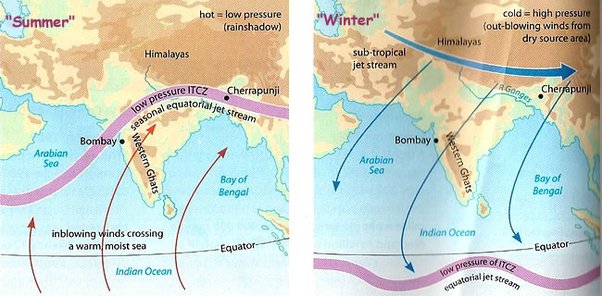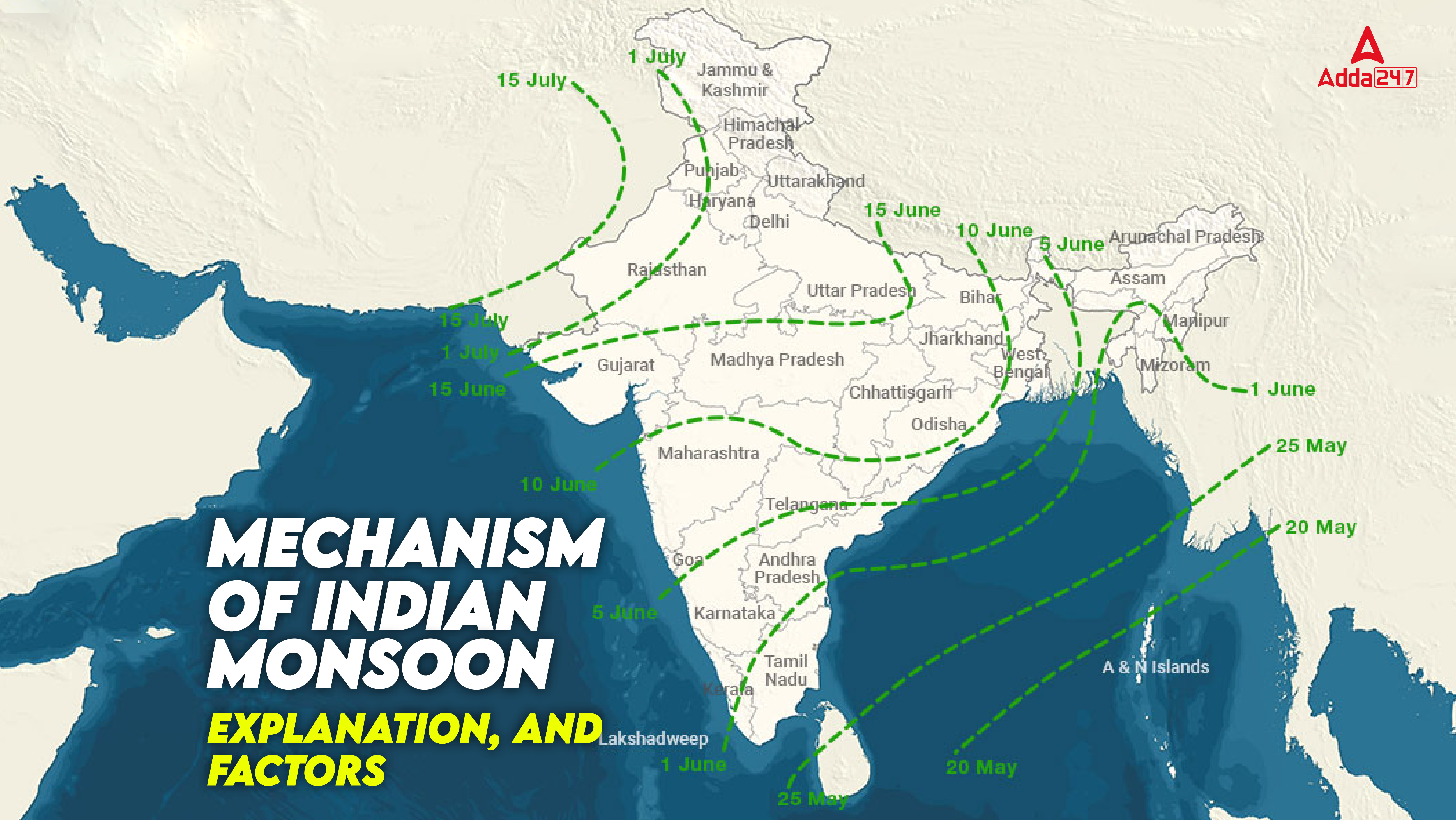Table of Contents
Geography is one such subject of General Studies from which many questions are asked in UPSC Pre and Mains exam, and the main reason for this is the vastness of the topics of Geography. One of the important topics in the broad topics of Geography is the mechanism of Indian monsoon, from which questions are repeatedly asked in the exam. Today’s article focuses on the mechanism of Indian monsoon. The mechanism of Indian monsoon is a big part of Indian agriculture and agriculture has a great dependence on it. Through this article, we will provide detailed information about the Mechanism of Indian Monsoon, explanation, and factors, which will greatly increase the chances of questions coming in your exam.
Mechanism of Indian Monsoon
The word monsoon derives its name from ‘Mausim’, an Arabic word meaning season. Monsoon means seasonal winds that blow continuously and regularly during a part of the year, while the rest of the time they are absent or blow in the opposite direction. This type of seasonal change is mainly due to the difference in the amount of heat received by different parts of the Earth from the sun.
The differential heating of land and sea causes a wind system to form with the change of seasons, which is mainly found in the tropical regions 20° north and 20° south of the equator. The summer monsoon is the south-easterly trade winds of the Southern Hemisphere, which are turned to the right by the Earth’s rotation as they cross the equator and turn into south-westerly winds. This prevailing wind system brings significant weather changes to the Indian subcontinent and surrounding areas.
Also Read- Western And Eastern Coastal Plains
Origin and Mechanism of Indian Monsoon
The monsoon of India is a complex system which is very difficult to understand completely. The origin of the monsoon still remains a mystery. Many attempts have been made to explain its mechanism, but no satisfactory explanation has been obtained so far. The functioning of the Indian monsoon is influenced by various factors, so many approaches and ideas have been used to understand it. The Indian monsoon, which transforms vast areas of India from semi-desert to lush green areas, is still not fully understood. To understand the mechanism of the Indian monsoon, it has been divided into two important parts: first, the classical theory and second, the modern theory.

Also Read- Western And Eastern Ghats
Classical Theory
Monsoons are also mentioned and described in ancient scriptures such as the Rig Veda. The first scientific study or mention of monsoon winds came from Arab traders. This is because Arab traders used sea routes to trade with India. In the tenth century, Arab explorer Al Masoodi described the reversal of sea currents and monsoon winds in the northern Indian Ocean. Later, Sir Edmund Halley explained that monsoons are the result of thermal contrasts caused by temperature differences between continents and oceans.
Modern Theory
Apart from differential heating, the shape of continents, mountain ranges, and air circulation conditions in the upper troposphere (jet stream) play an important role in the development of monsoon. Therefore, Sir Edmund Halley’s theory is no longer as relevant. Currently, modern theories based on air masses and jet streams are considered more important. These theories involve the study of atmospheric circulation, ocean currents, and other global climate systems, which help explain the complex mechanism of monsoon better.
Impact
Favourable monsoons increase agricultural production, stabilise prices and support other economic sectors, while poor monsoons raise prices, disrupt services and hamper industrial production due to shortages of raw materials. Agriculture is the backbone of the Indian economy as more than 60% of India’s population is engaged in agriculture, which contributes to about 20.5% of Indian GDP. Monsoon failure reduces GDP growth and negatively affects demand in non-agricultural sectors. The balance of trade also depends on monsoon patterns; favourable monsoons lead to a positive trade balance, while unfavourable monsoons cause trade deficits. Food supplies are directly affected, with failed monsoons reducing agricultural production and increasing food prices. Hydropower sectors and irrigation facilities dependent on perennial rivers suffer from low water levels during poor monsoons, affecting power generation and irrigation. The rural economy, centred on agriculture, is particularly vulnerable, with unseasonal rains damaging crops and reducing rural demand.
Factors of Mechanism of Indian Monsoon
The Indian monsoon system is influenced by many factors, including variable temperatures of land and water, rapid warming of the Tibetan Plateau in summer, high pressure areas east of Madagascar, tropical easterly jet, and Southern Oscillation. The climate of a place depends primarily on its location, relief, atmospheric pressure, and winds. India is divided into tropical and subtropical regions because of its location near the Tropic of Cancer. The Himalayan mountains block cold winds from the north and contribute to monsoon rains. Land-water distribution, distance from the sea, and altitude also affect temperature and atmospheric pressure. High pressure from central Asia brings dry winds in winter, while jet streams and cyclones influence the weather. India’s climate is tropical monsoon, influenced by its unique geographic location and position within the Asian continent. It has wet and dry seasons, although regions such as Ladakh and the Thar Desert do not experience typical monsoon patterns.
- Variable Temperature of Land and Water: Variations in the varying temperatures of land and water affect the development of monsoon.
- Heating of Tibetan Plateau: Rapid heating of Tibetan Plateau in summer is an important factor.
- High Pressure Area: The high pressure area east of Madagascar affects the monsoon.
- Tropical Easterly Jet: Atmospheric jet streams, especially the tropical easterly jet, play an important role in the mechanism of monsoon.
- Southern Oscillation: Irregular changes in sea surface temperature and winds in the tropical eastern Pacific Ocean also affect the monsoon.
- Latitude: India’s position near the Tropic of Cancer divides it into tropical and subtropical regions.
- Himalayan Mountains: These mountains block the cold winds blowing from the north and contribute to monsoon rains.
- Land-Water Distribution: The ocean and mountains affect air pressure, causing changes in monsoon winds.
- Distance from the Sea: Areas far from the sea experience more extreme weather.
- Elevation: High elevations are cooler as temperatures decrease with elevation.
- Relief: Terrain affects temperature, wind, and rainfall patterns.
- Surface pressure and winds: High pressure over central Asia brings dry winds to India during winter.
- Upper air circulation: Westerly winds and jet streams affect the weather pattern.
- Cyclones: Western disturbances from the Mediterranean affect northern areas, while tropical cyclones from the Bay of Bengal bring heavy rains to coastal areas.
| Related articles | |
| Floods | Mountain Passes Of India |
| Tropical cyclones | |




 TSPSC Group 1 Question Paper 2024, Downl...
TSPSC Group 1 Question Paper 2024, Downl...
 TSPSC Group 1 Answer key 2024 Out, Downl...
TSPSC Group 1 Answer key 2024 Out, Downl...
 UPSC Prelims 2024 Question Paper, Downlo...
UPSC Prelims 2024 Question Paper, Downlo...





